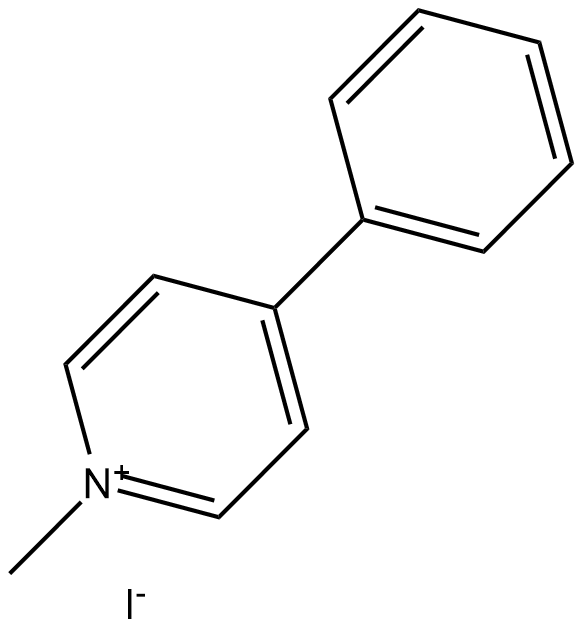MPP+ Iodide (Synonyms: N-Methyl-4-Phenylpyridinium Iodide) |
| Catalog No.GC18188 |
MPP+ yoduro (yoduro de 1-metil-4-fenilpiridinio) es un metabolito tóxico de la neurotoxina MPTP, y ha inducido con éxito síndromes similares a Parkinson en un modelo in vitro al destruir selectivamente neuronas dopaminérgicas en la sustancia nigra.
Products are for research use only. Not for human use. We do not sell to patients.

Cas No.: 36913-39-0
Sample solution is provided at 25 µL, 10mM.
MPP+ Iodide (1-methyl-4-phenylpyridinium iodide) is a toxic metabolite of the neurotoxin MPTP, and has successfully induced Parkinson-like syndromes in an in vitro model by selectively destroying dopaminergic neurons in substantia nigra.[1]
In vitro efficacy test it shown that when SH-SY5Y cells were exposed to MPP+ Iodidein the range of 1–100 M for 3–24 h, MPP+ Iodide exhibited a dose-time dependent cytotoxicity.[1] In vitro experiment it indicated that SH-SY5Y cells were treated with 0.2, 0.4, 0.8, or 1.0 mM MPP + for 24 h, MPP+ Iodide could significantly reduce cell viability in a dose-dependent manner.[2] In vitro, treatment with 1-7.5 mM of MPP+ Iodide dose-dependently increased the neurodegeneration in the L1 larvae of BZ555 worms. The percentages of worms exhibiting neurodegeneration after treatment with 1 mM, 2.5 mM, 5 mM and 7.5 mM MPP+ Iodide were 24%, 27%, 67% and 87%, respectively.[3] Both TSM1 and primary neurons were treated with 0.1 to 2 mM of MPP+ Iodide induced neuronal cell death in a concentration dependent manner in vitro. TSM1 cells and primary neurons were treated with 400 µM MPP+ Iodide decreased by 60% and 80% the cell viability as compared to the control, respectively.[4] In vitro to test the role of MAC1 in MPTP/MPP+-induced neurotoxicity, neuron-glia cultures were treated with 0.125, 0.25, or 0.5 μM of MPP+ Iodidefound that MPP+-induced DAergic neurotoxicity in neuron-glia cultures was attenuated in the absence of MAC1.[5]
In vivo study indicated that intranigral infusion of 3 µg/µl MPP+ Iodideinduced oxidative injury in nigrostriatal dopaminergic system of rat brain; and autophagy is pro-death in the MPP+-induced oxidative injury.[6]
References:
[1].Reudhabibadh R, et al. Suppressing Cdk5 Activity by Luteolin Inhibits MPP+-Induced Apoptotic of Neuroblastoma through Erk/Drp1 and Fak/Akt/GSK3β Pathways. Molecules. 2021 Feb 28;26(5):1307.
[2].Yan J, et al. Artemisinin attenuated oxidative stress and apoptosis by inhibiting autophagy in MPP+-treated SH-SY5Y cells. J Biol Res (Thessalon). 2021 Feb 25;28(1):6.
[3].Anjaneyulu J, et al. Differential effect of Ayurvedic nootropics on C. elegans models of Parkinson's disease. J Ayurveda Integr Med. 2020 Oct-Dec;11(4):440-447.
[4].Petit-Paitel A, et al. Involvment of cytosolic and mitochondrial GSK-3beta in mitochondrial dysfunction and neuronal cell death of MPTP/MPP-treated neurons. PLoS One. 2009;4(5):e5491.
[5].Hu X, et al. Macrophage antigen complex-1 mediates reactive microgliosis and progressive dopaminergic neurodegeneration in the MPTP model of Parkinson's disease. J Immunol. 2008 Nov 15;181(10):7194-204.
[6].Hung KC, et al. Roles of autophagy in MPP+-induced neurotoxicity in vivo: the involvement of mitochondria and α-synuclein aggregation. PLoS One. 2014 Mar 19;9(3):e91074.
Average Rating: 5 (Based on Reviews and 2 reference(s) in Google Scholar.)
GLPBIO products are for RESEARCH USE ONLY. Please make sure your review or question is research based.
Required fields are marked with *




